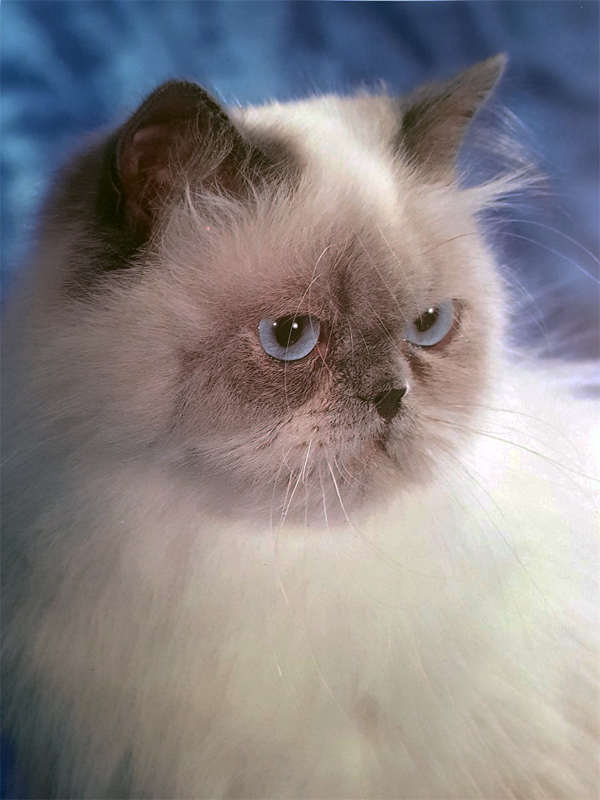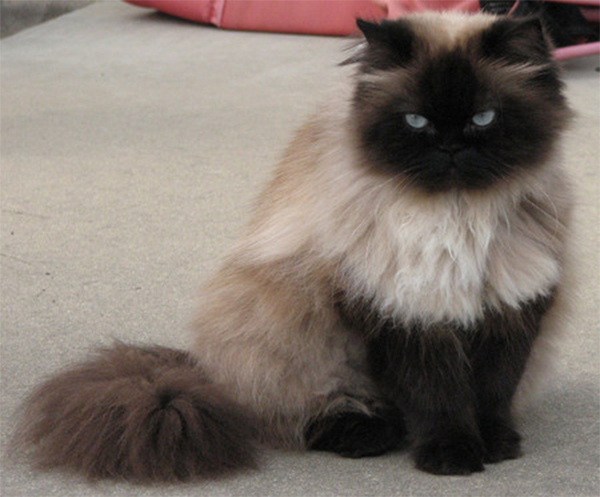The Himalayan, Himalayan Persian (or Colourpoint Persian as it is commonly referred to in Europe), is a sub-breed of long-haired cat similar in type to the Persian, with the exception of its blue eyes and its point colouration which were derived from crossing the Persian with the Siamese.
The creation of the ‘Himmy’ took years of selective breeding as the two cats from which it is derived are totaly different. The Persian then: is short stocky and heavy-boned, with long fur, whereas the Siamese: is long slim, and fine-boned and with short fur!
Cat of the Month ~ October 2019

Photograph: © Robert and Eunice Pearcy
It was in 1924 that a swedish geneticist start the cross breed process, by crossing a Siamese, Birman and a Persian cat. These trials were not completed it seems, and, it took a jump across the pond (careful Oscar) to Harvard Medical School 1930, where two medical students crossed Siamese with Smoke, Silver Tabby and Black Persians, producing a large number of short-haired kittens. Two of these kittens were mated, resulting in the birth of the first long haired black female Himalayan. When breeding this animal with her father (look away now, Oscar!) the resulting cat was the first Himalayan, with both points and long hair.
Some registries may classify the Himalayan as a long-haired sub-breed of Siamese, or a Colourpoint sub-breed of Persian. The World Cat Federation has merged them with the Colourpoint Shorthair and Javanese into a single breed, known as the Colourpoint.
The Cat Fanciers’ Association considers the Himalayan Persian simply a colour variation of the Persian, rather than a separate breed, although they do compete at Cat Shows in their own colour divisions. It was for the colour (only) that the breed was named “Himalayan”: a reference to the coloration of Himalayan animals, and in particular the Himalayan rabbit.
These cats are good natured, intelligent, and generally very social, but they have been known to be moody at times. Because of their heritage from the Siamese cats, they tend to be more active than Persians.
Himalayans are good indoor companion cats. They are gentle, calm and like most cats they are playful. Like the Siamese, most Himalayans love to stalk and chase balls of wool, mouse or fish toys and anything long and thin like string. Himalayans are devoted and dependent upon their humans for companionship and protection. They seem to really like the affection of a human and generally love to be petted and groomed.
Care for your Himalayan
If you want to bond with your Himalayan, why not spend half an hour grooming her a day/every day. She will love it if she is typical of her kind, and after all, this grooming is thought to be essential to the wellbeing of this feline.
Because they have long, silky hair that tangles and mats easily, a Himalayan’s coat should be brushed daily. This will remove and prevent tangling and mats, and help remove any dirt and dust (after all the coat will act like a duster around your home). Professional grooming is also recommended every few months to ensure their coat is healthy and clean, but for most this may be a little expensive.
Like all cats Himalayan’s love to sharpen thier claws, and what better place than the legs of your favourite occasional table. Many advise trimming of claws but we wouldn’t advise it (would we Oscar, you like your scratching too much for that). How about finding some soft material and putting that around the legs of your precious furniture, then we will all get along just fine. (so, please for Oscars sake, leave them paws alone)!
Examination of your cat weekly will uncover a multitiude of problems (well hopefully not). For example, Himalayans’ pointed ears are susceptible to capturing dirt and whatever else can fall from the sky or a hedge in your garden. This, if left undisturbed, can lead to irritation and later infection. So, if you see or find debris in your cat’s ears, use a pet ear cleaner and cotton ball to gently remove it. It is not advised to use cotton buds as the ears of all cats are so delicate and full of small capilliaries carrying blood (it can get messy and Oscar won’t thank you, no sir). If the ears are very red or inflamed, very dirty, or smell strongly, take her to the veterinarian as soon as possible, and get it checked out.
Finally, we’re glad to say that Himalayans are vary playful, but they will get into mischief if they become bored. So, the golden rule is – Get those cat toys out and Keep Playing. It’ll do you good too …..
Sources: Wikipedia.org, The Pictorial Encyclopedia of Cats by Britt Strader & others


